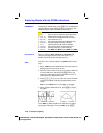
3-26 Function Graphing
8303FUNC.DOC TI-83 international English Bob Fedorisko Revised: 02/19/01 12:16 PM Printed: 02/19/01 1:35
PM Page 26 of 28
8303FUNC.DOC TI-83 international English Bob Fedorisko Revised: 02/19/01 12:16 PM Printed: 02/19/01 1:35
PM Page 26 of 28
zero finds a zero (x-intercept or root) of a function using
solve(. Functions can have more than one x-intercept
value;
zero finds the zero closest to your guess.
The time
zero spends to find the correct zero value
depends on the accuracy of the values you specify for the
left and right bounds and the accuracy of your guess.
To find a zero of a function, follow these steps.
1. Select
2:zero from the
CALCULATE
menu. The current
graph is displayed with
Left Bound?
in the bottom-left
corner.
2. Press
}
or
†
to move the cursor onto the function for
which you want to find a zero.
3. Press
|
or
~
(or enter a value) to select the x-value for
the left bound of the interval, and then press
Í
. A
4
indicator on the graph screen shows the left bound.
Right Bound? is displayed in the bottom-left corner.
Press
|
or
~
(or enter a value) to select the x-value for
the right bound, and then press
Í
. A
3
indicator on
the graph screen shows the right bound.
Guess? is then
displayed in the bottom-left corner.
4. Press
|
or
~
(or enter a value) to select a point near
the zero of the function, between the bounds, and then
press
Í
.
The cursor is on the solution and the coordinates are
displayed, even if
CoordOff format is selected. To move to
the same x-value for other selected functions, press
}
or
†
. To restore the free-moving cursor, press
|
or
~
.
zero


















